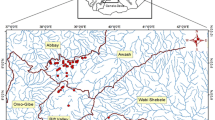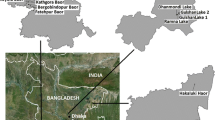Abstract
In response to the recent focus by the U.S. EnvironmentalProtection Agency on bioassessment of lakes, a multimetric index was developed for New Jersey lakes and reservoirs using benthicmacroinvertebrates. Benthic samples were collected fromreference and impaired lakes with muck and intermediate sedimentsin central and northern New Jersey during summer 1997. We used astepwise process to evaluate properties of candidate metrics andselected five for the Lake Macroinvertebrate Integrity Index(LMII): Hilsenhoff Biotic Index (HBI), percent chironomidindividuals, percent collector-gatherer taxa, percentoligochaetes/leeches, and number of Diptera taxa. We scoredmetrics as the fraction of the best expected value (based on allsites) achieved at a site and summed them into the LMII. Evaluation of the LMII showed that it discriminated well betweenreference and impaired lakes and was strongly related to severalpotential stressors. Chemical and physical gradients distinguished between reference and impaired lakes, and the LMIIsummarized these gradients well. The LMII corresponded stronglywith land use, but some lakes with more urban land use stillachieved high scores. Based on a power analysis, the ability ofthe LMII to detect differences in condition was sensitive to thenumber of samples from each lake.
Similar content being viewed by others
References
ASTM: 1998a, 'Standard Guide for Collecting Benthic Macroinvertebrates with Ponar Grab Sampler', in Biological Effects and Environmental Fate, Biotechnology, Pesticides, Vol. 11.05, ASTM, West Conshohocken, Pennsylvania, pp. 53–54.
ASTM: 1998b, 'Standard Guide for Selecting Grab Sampling Devices for Collecting Benthic Macroinvertebrates', in Biological Effects and Environmental Fate, Biotechnology, Pesticides, Vol. 11.05, ASTM, West Conshohocken, Pennsylvania, pp. 63–74.
Barbour, M. T., Stribling, J. B. and Karr, J. R.: 1995, 'Multimetric Approach for Establishing Biocriteria and Measuring Biological Condition', in W. S. Davis and T. P. Simon (eds), Biological Assessment and Criteria: Tools for Water Resource Planning and Decision Making, Lewis Publishers, Boca Raton, Florida, pp. 63–77.
Barbour, M. T., Gerritsen, J., Griffith, G. E., Frydenborg, R., McCarron, E., White, J. S. and Bastian, M. L.: 1996, 'A framework for biological criteria for Florida streams using benthic macroinvertebrates', J. N. Amer. Benthol. Soc. 15, 185–211.
Davies, S. P., Tsomides, L., Courtemanch, D. L. and Drummond, F.: 1995, Maine Biological Monitoring and Biocriteria Development Program, Maine Department of Environmental Protection, Bureau of Land and Water Quality, Division of Environmental Assessment, Augusta, Maine.
DeShon, J. E.: 1995, 'Development and Application of the Invertebrate Community Index (ICI)', in W. S. Davis and T. P. Simon (eds), Biological Assessment and Criteria: Tools for Water Resource Planning and Decision Making, Lewis Publishers, Boca Raton, Florida, pp. 217–244.
FDEP: 1996, Development of the Stream Condition Index (SCI) for Florida, Florida Department of Environmental Protection, Stormwater and Nonpoint Source Management Section, Nonpoint Source Bioassessment Program, Tallahassee, Florida.
FDEP: 2000, Development of Lake Condition Indexes (LCI) For Florida, Florida Department of Environmental Protection, Nonpoint Source Bioassessment Program, Tallahassee, Florida.
Green, J.: 1990, Freshwater Macroinvertebrate Species List Including Tolerance Values and Functional Feeding Group Designations for Use in Rapid Bioassessment Protocols, Report No. 11075.05, Assessment and Watershed Protection Division, U.S. Environmental Protection Agency, Washington, D.C. and Region 3, U.S. Environmental Protection Agency, Wheeling, West Virginia.
Hilsenhoff, W. L.: 1987, 'An improved biotic index of organic stream pollution', Great Lakes Entomol. 20, 31–39.
Johnson, R.A. and Wichern, D.W.: 1992, Applied Multivariate Statistical Analysis (3rd ed.), Prentice Hall, New Jersey, 642 pp.
Kelly, P. M. and White, J. M.: 1993, 'Preprocessing remotely sensed data for efficient analysis and classification, knowledge-based systems in aerospace and industry', Proc. SPIE 1993, 24–30.
Lemly, A. D.: 1996, 'Assessing the toxic threat of selenium to fish and aquatic birds', Environ. Monit. Assess. 43, 19–35.
Lenat, D. R.: 1993, 'A biotic index for the southeastern United States: Derivation and list of tolerance values, with criteria for assigning water quality ratings', J. N. Amer. Benthol. Soc. 12, 279–290.
Lewis, P. A. and Klemm, D. J.: 1990, Pollution Tolerance Values for RARE and EMAP Streams, U.S. EPA, Office of Research and Development, Cincinnati, Ohio (unpublished).
Lewis, P. A., Klemm, D. J. and Thoeny, W. T.: 2001, 'Perspectives on use of a multimetric lake bioassessment integrity index using benthic macroinvertebrates', Northeast. Nat. 8, 233–246.
Maier, K. J. and Knight, A. W.: 1993, 'Comparative acute toxicity and bioconcentration of selenium by the midge Chironomus decorus exposed to selenate, selenite, and seleno-DL-methionine', Arch. Environ. Contam. Toxicol. 25, 365–370.
Merritt, R. W. and Cummins, K. W.: 1996, An Introduction to the Aquatic Insects of North America (3rd ed.), Kendall/Hunt Publishing Co., Dubuque, IA.
Neter, J., Kutner, M. H., Nachtsheim, C. J. and Wasserman, W.: 1996, Applied Linear Statistical Models (4th ed.), McGraw-Hill, Boston, Massachusetts, 1408 pp.
NJDEP: 1998, New JerseyWater Quality Inventory Report, New Jersey Department of Environmental Protection, Trenton, New Jersey.
OEPA: 1987, Biological Criteria for the Protection of Aquatic Life, Vol. I: The Role of Biological Data in Water Quality Assessment, Ohio EPA, Division of Water Quality Monitoring and Assessment, Surface Water Section, Columbus, Ohio.
Resh, V. H. and Jackson, J. K.: 1993, 'Rapid Assessment Approaches to Biomonitoring Using Macroinvertebrates', in D. M. Rosenberg and V. H. Resh (eds), Freshwater Biomonitoring and Benthic Macroinvertebrates, Chapman and Hall, London, pp. 195–233.
SAS Institute: 1990, SAS/STAT User's Guide, v. 6, Vol. 2, 4th ed., SAS Institute Inc., Cary, North Carolina.
Simon, T. P. and Lyons, J.: 1995, 'Application of the Index of Biotic Integrity to Evaluate Water Resource Integrity in Freshwater Ecosystems', in W. S. Davis and T. P. Simon (eds), Biological Assessment and Criteria: Tools for Water Resource Planning and Decision Making, Lewis Publishers, Boca Raton, Florida, pp. 245–262.
Southerland, M. T. and Stribling, J. B.: 1995, 'Status of Biological Criteria Development and Implementation', in W. S. Davis and T. P. Simon (eds), Biological Assessment and Criteria: Tools for Water Resource Planning and Decision Making, Lewis Publishers, Boca Raton, Florida, pp. 81–96.
USEPA: 1990, Macroinvertebrate Field and Laboratory Methods for Evaluating the Biological Integrity of Surface Waters, EPA/600-4-90/030, U.S. EPA, Cincinnati, Ohio.
USEPA: 1993, Inorganic QA/QC Plan, U.S. EPA, Region II, Technical Support Branch, Edison, New Jersey.
USEPA: 1994a, Standard Operating Procedure C-10: Method for Mercury Analysis in Soil/Sediment by Manual Cold Vapor Technique, U.S. EPA, Region II, Environmental Sciences Division, Edison, New Jersey.
USEPA: 1994b, Standard Operating Procedure C-8: Determination of Trace Metals in a SoilMedium by Inductively Coupled Plasma Emission Spectroscopy, U.S. EPA, Region II, Environmental Services Division, Edison, New Jersey.
USEPA: 1995, Standard Operating Procedure C-74: Selenium, Arsenic, and Antimony Analysis in Marine Sediments by Hybride Generation Flow Injection Atomic Absorption, U.S. EPA, Region II, Environmental Services Division, Edison, New Jersey.
USEPA: 1997, Environmental Monitoring and Assessment Program-Surface Waters: Field Operations Manual for Lakes, EPA 620-R-97-001, U.S. EPA, Washington, D.C.
USEPA: 1998a, Environmental Monitoring and Assessment Program-Surface Waters: Field Operations and Methods for Measuring the Ecological Conditions of Wadeable Streams, EPA/620/R-94/004F, U.S. EPA, Research Triangle Park, North Carolina.
USEPA: 1998b, Lake and Reservoir Bioassessment and Biocriteria: Technical Guidance Document, EPA 841-B-98-007, U.S. EPA, Washington, D.C.
USEPA: 1999, Rapid Bioassessment Protocols for Use in Wadeable Streams and Rivers, EPA 841-B-99-002, U.S. EPA, Washington, DC.
USEPA: 2000a, QA/QC Plan for Sanitary Chemistry Section, U.S. EPA, Region II, Laboratory Branch, Sanitary Chemistry Section, Edison, New Jersey.
USEPA: 2000b, Standard Operating Procedure C-33: Total Suspended Solids, U.S. EPA, Region II, Environmental Services Division, Edison, New Jersey.
USEPA: 2000c, Standard Operating Procedure C-94: Determination of Anions in Aqueous Samples, U.S. EPA, Region II, Environmental Services Division, Edison, New Jersey.
Vogelmann, J. E., Sohl, T. L., Campbell, P. V. and Shaw, D. M.: 1998, 'Regional land cover characterization using Landsat Thematic Mapper Data and Ancillary Data Sources', Environ. Monit. Assess. 51, 415–428.
Author information
Authors and Affiliations
Corresponding author
Rights and permissions
About this article
Cite this article
Blocksom, K.A., Kurtenbach, J.P., Klemm, D.J. et al. Development and Evaluation of the Lake Macroinvertebrate Integrity Index (LMII) for New Jersey Lakes and Reservoirs. Environ Monit Assess 77, 311–333 (2002). https://doi.org/10.1023/A:1016096925401
Issue Date:
DOI: https://doi.org/10.1023/A:1016096925401




